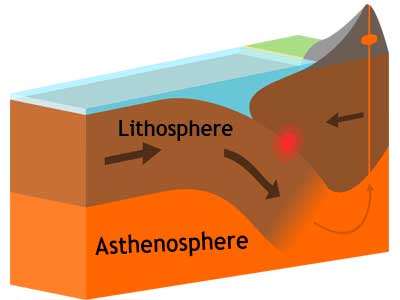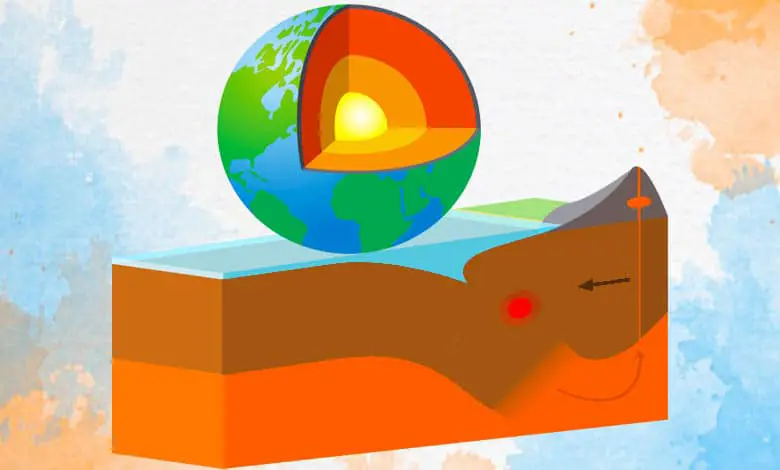Hello, globe trotters and earth science enthusiasts! Are you ready to journey into the depths of our planet, far beneath the ground we walk on? Today, we’re setting off on an exciting expedition to explore the asthenosphere, a mysterious and dynamic layer of the Earth that plays a crucial role in shaping the planet’s surface. This layer, nestled between the rigid lithosphere above and the more solid lower mantle below, is where the magic of plate tectonics and volcanic activity begins.
The asthenosphere is mostly solid, but it’s able to flow. We call that liquidus. It is a hot, weak zone representing the upper mantle. The asthenosphere looks like a liquid, but it’s not liquid. There’s a good reason for this misconception. It is what we refer to as viscoelastic. It means under certain conditions, it’s elastic, and under other conditions, it can deform as a plastic material.
So, earthquake waves are also elastic waves. They’re elastic defamations, and they’re very capable of propagating through the asthenosphere of the earth. Yet, under other conditions, the Asthenosphere is capable of falling. It is one of the important layers of the earth’s surface that maintains other surfaces and keeps the earth flexible enough to move.
Lace-up your virtual hiking boots and grab your explorer’s hat; we’re about to delve deep into the Earth to uncover the secrets of the asthenosphere. Prepare to be amazed by the wonders that lie just beneath our feet!
What is the Asthenosphere made of?
Astheno comes from the Greek word week, and sphere means surface. So, the asthenosphere means a weak surface. The asthenosphere is the upper layer of the earth’s mantle. It sits above the boundary between the upper and lower parts of the mantle.
Also, it sits above the outer and inner core but below the lithosphere. The asthenosphere has a relatively low resistance to plastic flow. So, it’s a little more capable of fluid motion than the solid lithosphere.

When we go into plate tectonics, the lithospheric plates move around on a surface. That is fluid that is capable of flow. It means that the plates can move relative to one another, not necessarily in the same direction or at the same speed. So, the convection currents in the asthenosphere are assumed to be responsible for these relative motions.
Composition
There is some difference in the composition of the materials, the rocks, and the minerals that make up the crust or upper part of the mantle. The asthenosphere is the middle section of the mantle. The Earth’s asthenosphere is also made up of reasonably solid peridotites.
About 99% of the asthenosphere is solid rock, and the other 1% is molten-like magma. The asthenosphere is hot, which makes it mechanically weak compared to the lithosphere.
The rocks that are less in silica and high in magnesium, iron, and asthenosphere are found. The asthenosphere would be seismic waves like earthquake waves generated when a quake happens. It is also called the low-velocity zone. Why do we call it the velocity zone? It is possible more than in nature because it is partially molten. It is not completely solid, not completely liquid.
- Most of the earth’s mantle is rocks that are regarded as silicates. Silicates are a network structure and a link between silicon and oxygen. Common silicate found in the mantle includes olivine, garnet, and pyroxene.
- Another primary rock type is magnesium oxide.
- Ions are significant because they are a key element in the core. Also, It’s the reason why the core is magnetic.
Structure
In the asthenosphere, ductile deformation occurs. When something deforms the duct tightly, it is thought to be put under strain. It doesn’t fracture, and it stretches out and deforms. The asthenosphere does not make up all of the mantle or the remaining part of the mantle. The asthenosphere is thicker than the lithosphere, making it a relatively small mantlepiece.
The lithosphere is very rigid and very hard to deform. The asthenosphere is fairly easy to deform. It works like toffee. If you squash toffee, change its shape, and deform it, that’s called plastic deformation. The same thing happens to rocks in the asthenosphere but much more slowly.
The asthenosphere is malleable, ductile, and impartial mold in a state. That is why we call the asthenosphere the plastic layer of the surface. Its plasticity makes tectonic plates move on top of the outer sphere. These plates are rigid, solid, and less dense. The asthenosphere is partially molten and higher in density. These plates’ properties are floating across the asthenosphere.
Thickness
The asthenosphere is generally between where the lithosphere ends. They are anywhere between 50 and 200 kilometers in depth. One of the shallowest points at which the lithosphere will end averaged a bit obvious would be lower, mainly in the oceanic crust.
Temperature
As far as temperature goes, the asthenosphere is down to that point in the mantle, where the temperature increases much more quickly. The upper boundary is usually around 1300 degrees Celsius. The top of the asthenosphere is 1,300 degrees Celcius. Basaltic lava, the hottest type of lava on earth, erupts in Hawaii’s volcanoes. This stuff is 1,200 degrees Celsius. So, the asthenosphere is hotter than lava.
Pressure: This layer’s pressure is about 18 GPa and gradually builds up in the thicker regions.
Location: It is located between seventy-two to 250 kilometers beneath the surface.
Asthenosphere Characteristics (Facts)
The asthenosphere plays a crucial role in plate tectonics and the movement of the lithospheric plates. Here are its key characteristics:
Physical State: The asthenosphere is composed of partially molten rock. While it is predominantly solid, molten material makes it plastic or ductile, allowing it to flow very slowly under pressure. This plasticity is due to the high temperature and pressure conditions that partially melt the silicate materials in this zone.
Composition: The asthenosphere is made up of peridotite, a dense, dark igneous rock consisting primarily of the minerals olivine and pyroxene. The slight melting of peridotite in the asthenosphere is what gives it its plasticity.
Role in Plate Tectonics: The asthenosphere is crucial for the movement of tectonic plates. Its plasticity allows the lithospheric plates to move over it, facilitating processes such as continental drift, ocean floor spreading, subduction, and the formation of mountains. The flow and movement within the asthenosphere can also contribute to forming mantle plumes, which can lead to volcanic activity.
Seismic Waves: The asthenosphere affects the velocity of seismic waves generated by earthquakes. Seismic waves slow down as they pass through the asthenosphere due to its partially molten state, which helps scientists delineate the boundaries of this layer.
Viscosity: The asthenosphere’s viscosity is much lower than that of the surrounding mantle, making it significantly more deformable. This lower viscosity is key to its ability to flow and deform under tectonic forces.
Last Words
Through our journey, we’ve discovered how this viscous, semi-fluid layer beneath the lithosphere is the unsung hero of plate tectonics, facilitating the movement of tectonic plates and contributing to the dynamic nature of our planet’s surface. It’s a world of incredible heat, pressure, and constant motion, hidden beneath our feet, yet instrumental in shaping the Earth as we know it. We hope this expedition has ignited a spark of curiosity and wonder in you about the incredible processes that occur deep within our planet.
Thank you for joining us on this deep dive into one of Earth’s most intriguing layers. Until our next adventure into the mysteries of our planet and beyond, keep exploring, keep questioning, and never stop marveling at the extraordinary world around us. Stay curious, adventurers!
More Articles:
What Is The Lithosphere Made Of With Definition & Structure
What Is The Troposphere With Composition & Temperature
How Does Magma Form With Composition & Characteristic
What Is The Mesosphere With Characteristics & Facts
References:
Barrel. “The strength of the crust, Part VI. Relations of isostatic movements to a sphere of weakness – the asthenosphere.” The Journal of Geology.
Harsh Gupta. Encyclopedia of Solid Earth Geophysics. Springer Science & Business Media.
Lev Eppelbaum; Izzy Kutasov; Applied Geothermics. Springer Science & Business.
Czechowski, L.; Grad. “Two mechanisms of formation of asthenospheric layers.”
Table of Contents
